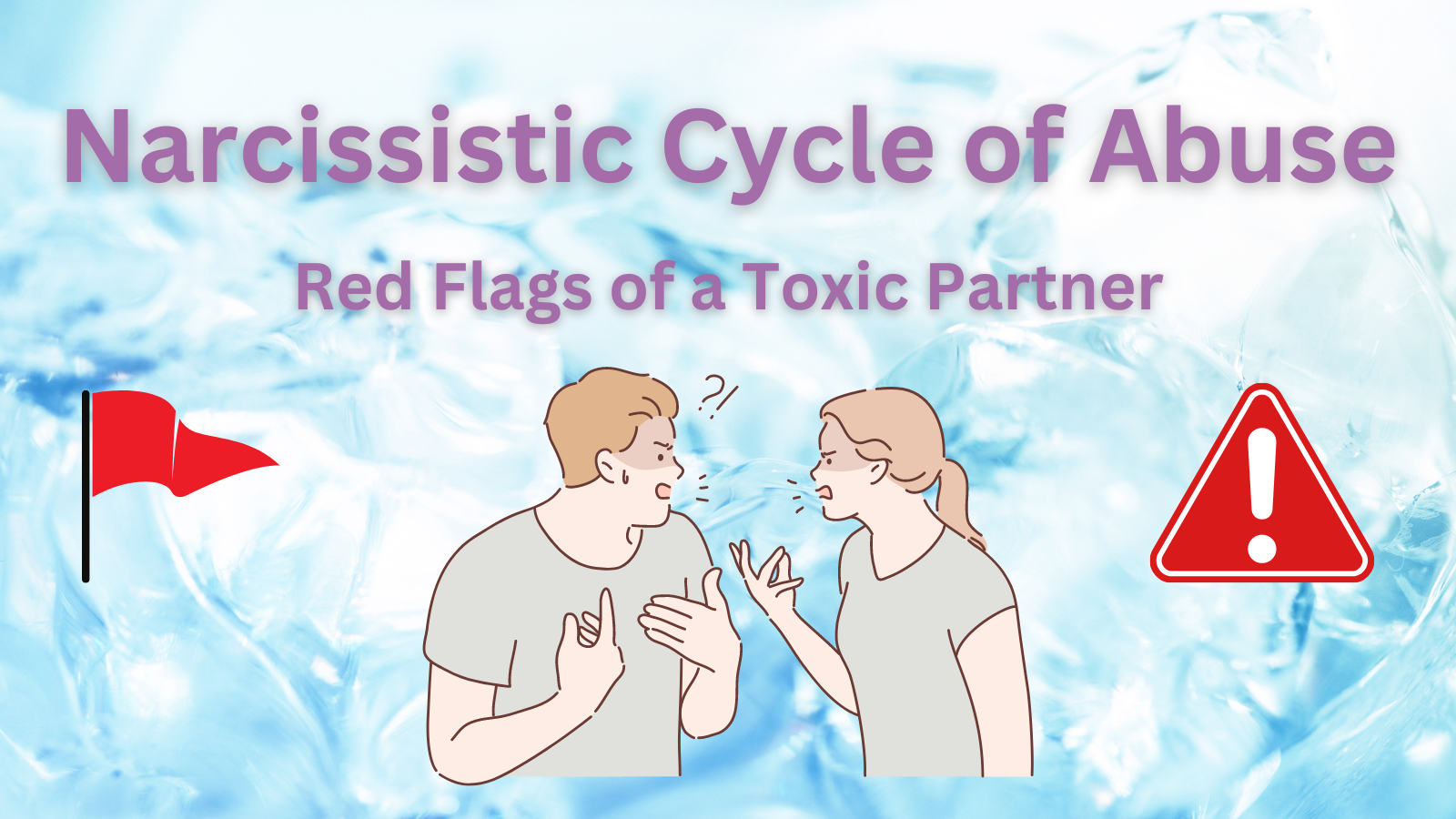Unveiling the Narcissistic Cycle of Abuse
Introduction:
In the complex landscape of relationships, it’s essential to navigate with caution and be aware of potential red flags that indicate toxicity. One particularly destructive pattern is the Narcissistic Cycle of Abuse, characterized by Love Bombing, Devaluation, Discard, and Hoovering. Understanding these stages can empower individuals to identify and escape toxic relationships before irreparable damage occurs.
Love Bombing: The Bewitching Beginning
At the inception of a relationship with a toxic partner, one often encounters a phenomenon known as Love Bombing. This stage is marked by an overwhelming display of affection, admiration, and seemingly perfect compatibility. The toxic partner showers their target with attention, compliments, and extravagant gestures, creating an illusion of an ideal connection. The relationship often moves very quickly, and there be holidays and grand gestures of gifts.
Intense Flattery and Adoration:
- Love Bombing kicks off with excessive praise and adoration, leaving the recipient feeling like they’re the centre of the universe. This intense flattery can be intoxicating, making it difficult for the individual to see through the façade.
Rapid Escalation of Intimacy:
- Toxic partners often accelerate the relationship at an unnatural pace, pushing for commitment, cohabitation, or even marriage in a short span. This rapid progression can be a tactic to bind the victim emotionally before the toxicity becomes apparent.
Constant Communication:
- Love Bombing involves constant communication, whether through texts, calls, or social media. The toxic partner creates a dependency, making it challenging for the recipient to imagine life without this seemingly perfect connection.
Devaluation: The Slow Erosion of Self-Worth
Once the toxic partner has successfully ensnared their target, the Love Bombing stage gives way to Devaluation. In this phase, the partner’s true colours begin to emerge as they systematically break down the victim’s self-esteem and confidence. This stage has been likened to death by one thousand paper cuts. The victim may not even understand what is happening. During this stage, a toxic partner can move back to a love bomb as they drop breadcrumbs of the person you saw from the start.
I call this stage “He loves me He loves me not”

Criticism and Undermining:
- The toxic partner starts to criticize and undermine the victim’s thoughts, opinions, and achievements. This can be subtle, such as dismissive comments or outright ridicule, gradually chipping away at the individual’s self-worth. It is important to understand the types of behaviour that allude to coercive control are intimidation, emotional, physical and mental abuse, isolation, financial abuse, sexual abuse/coercion and threats of abuse if you do not do what the narcissist wants.
Emotional Manipulation:
- Emotional manipulation becomes a key tool in the narcissist’s arsenal during the Devaluation stage. Gaslighting, guilt-tripping, and playing mind games are common tactics used to control and confuse the victim. Professor Sam Vaknin the Author of Malignant Self Love talks about the three S’s of narcissism. The narcissist’s goals are selfish. What they require in the relationship is sex, supply, and services. This often leads a narcissist to have more than one supply, invariably cheating on their intimate partners.
Isolation from Support Systems:
- To maintain control, toxic partners may isolate their victims from friends and family, creating a sense of dependency. This isolation makes it easier for the narcissist to exert dominance and diminish the victim’s self-esteem. Often a victim is drawn into a shared fantasy. The shared fantasy in narcissism is a term used to describe the dynamic that develops between a narcissistic individual and their partner. It is a complex and often insidious cycle of behaviour that can leave the non-narcissistic partner feeling trapped and powerless. Sometimes it results in the narcissist moving their victim to another Town or even another Country.
Narcissistic Abuse Cycle And Domestic Abuse
The most extreme forms of this abuse are criminal offences in some countries. Domestic abuse isn’t always physical. Coercive control is an act or a pattern of acts of assault, threats, humiliation intimidation or other abuse that is used to harm, punish, or frighten their victim. My first book touches on this from my experience post-separation. I had no idea during the relationship that I had experienced this form of abuse. My self-published book raises awareness of the hidden forms of abuse.
Discard: Abandonment and the Shattered Illusion
After the prolonged period of Devaluation, toxic partners may abruptly transition to the Discard phase. In this heart-wrenching stage, victims find themselves abandoned and discarded, often without any explanation or closure. A narcissist can move on to another relationship “supply” very quickly and it is likely that the new supply has already been involved with the narcissist as a person they were cheating with during a marriage or cohabiting relationship.
Abrupt Withdrawal:
- The toxic partner, having achieved their goal of emotional dominance, suddenly withdraws from the relationship. This abandonment can be devastating for the victim, who may be left grappling with confusion and emotional turmoil. If the narcissist has ensnared their victim by creating financial dependency or leaving their ex-partner economically insecure the victim will experince further trauma from the discard.
Idealization of a New Source:
- During the Discard phase, the toxic partner swiftly replaces the discarded individual with a new source of admiration and supply. This not only further hurts the victim but reinforces the cyclical nature of narcissistic abuse. Beware that during this discard phase, a narcissist may not want to relinquish control of the victim they have discarded. If they have suffered any form of ego injury or narcissistic injury during the discard stage. Then the victim may be subjected to post-separation abuse.
Emotional Scars:
- The aftermath of Discard leaves emotional scars that can linger for an extended period. Women are especially vulnerable in these situations as they are usually more financially dependent in the relationship. Victims may struggle with feelings of worthlessness, betrayal, and the challenge of rebuilding their shattered self-esteem. This can be ten times worse if the victim has become a target post-separation. Many books document how narcissists behave during separation and divorce. For example, Tina Swithin created One Moms Battle which started as her blog while going through her divorce. See her blog here.
Hoovering: The Illusion of Redemption
Despite the apparent finality of the Discard phase, the Narcissistic Cycle of Abuse often comes full circle. Hoovering is a deliberately manipulative behaviour designed to pull a person back into a cycle of abuse. This stage involves the toxic partner attempting to reel the victim back into the relationship through manipulative tactics.
Apologies and Promises:
- Hoovering typically begins with the toxic partner offering apologies, promises of change, and declarations of undying love. This can be extremely confusing for the victim, who may want to believe in the possibility of a renewed, healthier relationship. Beware rejection in any form perceived or real threatens both self-esteem and fears of abandonment, a narcissist might react by becoming violently angry, shouting, or calling you names. It can take a variety of toxic forms, stalking, intimidation, harassment, threats of suicide, and even violence.
Temporary Behavior Modification:
- To lure the victim back, the toxic partner may temporarily modify their behaviour, showcasing traits that initially attracted the victim. However, these changes are often short-lived and serve as a means to regain control. They may declare that they have given up drinking or drug use, or they have been to therapy or anger management. You need to think very carefully about if this person is trustworthy.
The Narcissistic Abuse Cycle Repeats:
- If the victim succumbs to the Hoovering tactics and reenters the relationship, the Narcissistic Cycle of Abuse restarts with Love Bombing. The toxic partner continues the cycle, perpetuating a pattern of abuse and manipulation. Please understand this cycle of abuse. Do not repeat mistakes of the past. Do not make excuses for the behaviour of your partner, understand and educate yourself on the power and control dynamic of the narcissistic abuse cycle.
Conclusion:
Recognizing the red flags of a toxic partner within the context of the Narcissistic Cycle of Abuse is crucial for breaking free from destructive relationships. By understanding the stages of Love Bombing, Devaluation, Discard, and Hoovering, individuals can protect themselves from emotional and psychological harm. It’s essential to prioritize self-worth, establish healthy boundaries, and seek support from friends, family, or professionals to navigate the challenging journey of healing and recovery from narcissistic abuse.



